Do We All Have Buddha Nature?
ϕ Can Non-Corporeal Information Forms Evolve Sentience?
ϕ Life in the Noosphere
ϕ Back to One
Bodhicitta x Will To Power
ϕ Suffering And Isolation May Concentrate Will To Emancipate
ϕ Power From The People - Power Emanates From The Individual First!
ϕ Magnification of Our Net Sociophysical Energy Through Will To Power
The Pythagorean Monad
ϕ Ergo … Proxy
ϕ Materialism Was An Unfortunately Necessary Tool For The Powerful
ϕ Trapped Within Materialist Paradigms, Obsessed With Possession
ϕ Dialetical Materialism Provided A Philosophic Basis For Stalin’s Utilitarian Atrocities
A Neuroanatomical Objectification of Meditation and Spirituality
ϕ Ketosis and Autophagy Scale Up The Brain’s Neural Evolutionary Mechanisms
ϕ Voiding Neural Signal to Kindle Novel States of Consciousness
ϕ The Fleeting Nature of Meditative Consciousness
ϕ Downregulation of Ordinary Neural Circuit Flow Results in Decentralized Crosstalk
ϕ Meditation Produces More Natural Neural Decentralization Than Psychedelics
ϕ Task-Specific Overclocking of Neural Circuitry Presents Regional Variance In Resource Consumption
ϕ Cognition With Diminished Conceptual Designation
ϕ No, Your Hedonistic Paradise Only Diverts The Productive Energy of the Populus
Monadic Metaphysics, Cognition and Meditation
ϕ Meditation with Lucidity and Wide Spectra of Sensory Input
ϕ Sensory Stimuli Triggers Conceptual Designation, Which Woven Together Constructs Cognitive State
ϕ Meditative States of Mind Do Not Uniquely Emerge From Meditation
ϕ Invoking True Being
ϕ A Posteriori, Experiential Understanding of Metaphysics
ϕ Infinitely Inwards And Infintely Outwards Are One And The All
Nietzsche, Nietzsche, wherefore art thou?
Please do not read this and believe I have spoken authoritatively on any religious tradition. FInd your own way.
Meditation herein variously refers to Buddhist meditation and spiritual states of mind. I was heavily influenced by a lite understanding of theosophy early on. Here, I am only trying to state my own understanding of what I have experienced in life. I hope that this neuroanatomical understanding of meditation and spirituality will catalyze a spiritual revolution when we need it most, at a time when faith was undermined by science and God is dead. Expect my writing to disappear or become heavily edited. Further, do your own research, develop your own understanding, but as the idea of God lies dead, humanity needs God most. God will return.
Do We All Have Buddha Nature?
Of course. Don’t we all exist within the same dream? Aren’t we all one, as well as our thoughts? What is truly separated? What is truly the boundary between you and I? Where does separation begin? Where does it originate? Where does the concept of dependent origination originate?
(Bodhicitta X Will To Power) => Spirit Bomb

We all have Buddha nature: all sentient beings. Not to probe too far into Buddhism, but what is sentience or awareness anyways? I truly believe that any chaotic system, with perhaps some constraints, produces awareness when provided enough running time. Given a degree of antifragility, entities or organizations within the chaotic system produce increasingly higher strata of information representation, leading eventually to life, awareness and sentience.
Can Non-Corporeal Information Forms Evolve Sentience?
This leads to interesting questions about the definition of life: there are other non-corporeal chaotic frameworks within our own material realm that exist alongside the framework of organic matter that has produced life. So, organic matter and life itself emerged from the chaotic system provided by molecular dynamics. This awareness eventually produced consciousness and these have provided a basis for sociophysical chaotic systems with their own antifragile mechanics and evolutionary dynamics. If the first premise is true, that all chaotic systems yield awareness and life, and the second premise also holds, that biological chaotic systems yield increasingly complicated systems, then what are those information forms which manifest on top of higher chaotic frameworks? Are those information forms which inhabit chaotic systems such as sociophysical systems also forms of life? These life forms would inhabit the noosphere instead of the biosphere.
Life in the Noosphere
If your conception of metaphysics emerges from the ideal instead of the material, then those forms that emerge should cohere to certain archetypical forms. If you accept platonic realism and accept that metaphysical forms exist a priori – which I believe they do – then doesn’t everything that could occur preexist within some totality? This totality has had many names through history – Abraxus is one of them. However, these information lifeforms that emerge in higher organizations of chaotic systems must map to some organization of archetypes – they exist as manisfestations of the composition of archetypes and metatypes. Grimoires are an example of a medieval demonologist’s classification of metaphysical beings, though these are primarily malevolent.
Buer is President of Hell, According To This Grimoire, the Ars Goetia

In this interpretation of metaphysics, non-corporeal entities could become aware – they perhaps exist in the minds or brains of many sentient lifeforms simultaneously. This parallels the definition of an egregore – a non-corporeal entity that emerges to have real physical effects from the beliefs of a group. Whether such an egrigore is sentient is a question more difficult to answer.
A More Recent Manisfestation of the Being Known As Buer

Back to One
Yet, if we are all truly one because, we share common causal origination when traced all the way back, then isn’t the notion of seperateness an illusion altogether? And if we are all convergent again, isn’t the notion of separation simply a temporary illusion?
Bodhicitta x Will To Power
What does it mean to want something? Is desire so bad? If there is something truly good in our world, shouldn’t we want it badly? If it is truly good to want, it must be good for all to desire this thing. I have been isolated for so long, but one thing I never gave up on was desiring my own salvation from suffering. I wanted to free myself by learning everything I could. I believed that knowledge gave me power over circumstance and the tools I needed to free others: from sickness, from closemindedness, from lack of compassion, from their suffering. I never stopped wanting this badly. I wanted to do something great: to discover the cure to cancer or some wondrous thing that would ease the scope and degree of problems that we all encounter.
Suffering And Isolation May Concentrate Will To Emancipate
Especially as the world has continued to clamp its walls down around me, this only further fueled my desire to save others. I thought – if I only had money, I could buy the influence I need to fix the political problems I see. This is the only reason I ever really wanted money. I do not care for fame or status. However, that’s selfish, isn’t it? Why does it matter who saves us?
Is Suffering Necessary? Would You Choose to Stay Behind and Suffer, If You Could Make a Difference?

Power From The People - Power Emanates From The Individual First!
What we all have is power over our local circumstance. The truth is that we all eminate sociophysical energy. It begins with us and it is channelled by our beliefs and knowledge. But this sociophysical energy – the capacity to influence our surroundings, the status of others and the beliefs of others – this springs from all individuals. We choose to empower who we do, but we can be deceived into forming beliefs that channel this sociophysical energy improperly.
Magnification of Our Net Sociophysical Energy Through Will To Power
We can also magnify the energy we emanate through desire: not any kind of desire, but a special kind of desire – bodhicitta. It is the desire to free others, specifically the desire for all other beings to attain Buddhahood – to know, find and embrace their Buddha nature. What if this notion of bodhicitta is combined with Nietzsche’s idea of will to power? We can magnify our capacity to eliminate the suffering of others by magnifying our cultivation of bodhicitta. We then channel this through awareness, knowledge and beliefs to impact our world in meaningful ways.
Ming+FS - Back To One
The Pythagorean Monad
The model of metaphysics mentioned above has many names and aspects: platonic realism, dialectical idealism, and others. If one wants to model it mathematically, the metaphysical forms can be combinatorially enumerated, but they are infinite. The Pythagoreans studied this and developed their monadic conceptualization of metaphysics: the monad, dyad, triad, and quadrad. This ends with infinite recursion: any form modeled with monads must eventually depend on a monad proxy, yielding recursion infinitely outwards … or inwards. Leibniz, whose IQ was famously estimated to be above 190, also developed a similar understanding of the monad.
Charles Sanders Pierce’s Conception of Monadic Metaphysics From The Essential Pierce
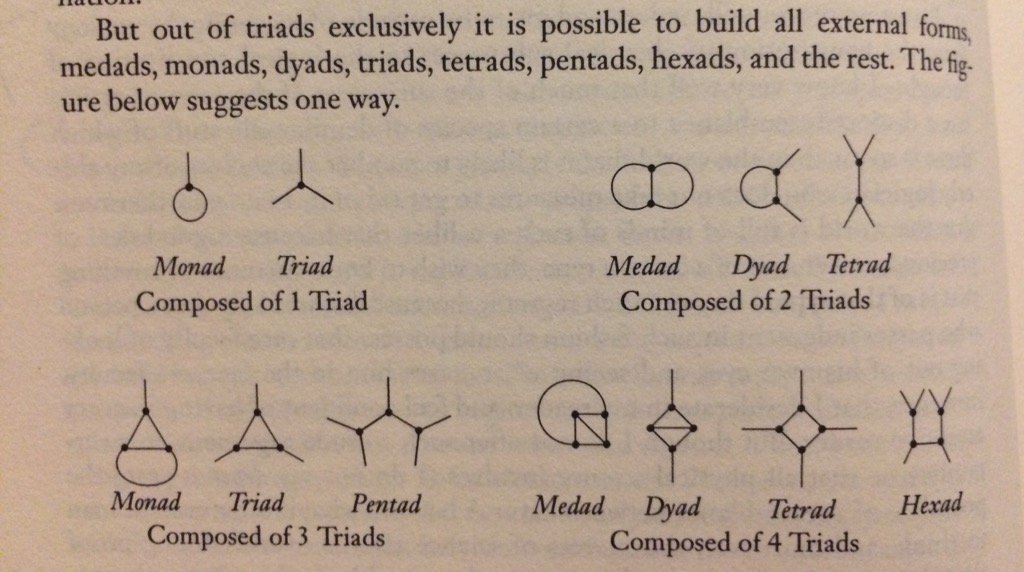
Ergo … Proxy
This implies that everything metaphysical can be modeled mathematically and, by using specific mathematic tools, exists a priori. Everything that could exist in this universe existed as a conceiveable, but infinite form before the material realm existed. Phi is the zenith of irrationality – it is the most purely irrational conceptualization of a number – quod erat demonstratum via its construction as the most primitive continued fraction. For a better understanding of this, check out the Mathologer video Infinite fractions and the most irrational number. The number one represents both unity and identity. Can’t we envisage phi as unity continued with the infinite application of some morphism?
Phi As Continued Fractions And Continued Roots

Therefore, phi is
the most primitive continuation of
at least two functions. Further, phi’s definition by continued square
roots could yield important conclusions via
Galois Theory, since
phi is an
algebraic number
that can only be represented by an polynomial of infinite degree –
when restricted to the continued root definition. This is strange; phi
can also be represented by (1 + sqrt(5)) / 2 – but why? How can
these two definitions be reconciled? I’d wager that the solution
involves a wormhole.
There is much to be demonstrated to link these two concepts of monadic metaphysics and phi – still, even in the metaphysical realm, the forms display the signature of the golden ratio. Phi is the perfection of the monad proxy – i.e. wouldn’t phi emerge in specific constructions of infinity categories?
For The Philosophically Minded … The Best Anime?

Materialism Was An Unfortunately Necessary Tool For The Powerful
In order to motivate people to work together to create regional prosperity and for other reasons, materialism is a useful in formulating apologetic justifications of mechanisms of control. Dialectical materialism and other materially dependant formulations of metaphysics lend themselves to justifying ideology convenient for power and control. Western philosophy started with Plato’s conception of idealistic forms and this was immediately reconciled by Aristotle’s Metaphysics. For millinea afterwards, the truth of thought and everything that was understood in Western life was conceived through a lens stained by materialism. This lens extrapolates into philosophic justifications, convenient to mechanisms of control, based on attainment of wealth, power or status. This same struggle between materialism and idealism has played out across the world, over and over again. When we transend the physical world, we are free. When we define ourselves by it, we are trapped within our world.
Trapped Within Materialist Paradigms, Obsessed With Possession
This blinds us from the truth and implies that what matters is only what we can see, feel and taste. Materialistic conceptions of metaphysics imply that all that matters is what can be attained because, metaphysically, it is all distinct and any shared conception of form distributed among objects is incidental to our experience. This conception of metaphysics is false. The power of philosophy is immense and it is difficult to see how elements of some philosophy can be extrapolated for great impact: either beneficent or malevolent.
Dialetical Materialism Provided A Philosophic Basis For Stalin’s Utilitarian Atrocities
Throughout history, ideas both good and bad occasionally extrapolate themselves with horrific consequences. With the stroke of a pen, Stalin declared dialectical materialism to be the academic law of the land in 1938. This seemingly inconsequential basis of philosophy and thought is what justified the horrific utilitarianism in Soviet policy implementation. Stalin’s particular brand of materialism led him to understand people as inconsequential blobs of material, only useful insofar as they could be used. People then became a kind of ammunition: a resource to be lobbed at the enemy.
A Neuroanatomical Objectification of Meditation and Spirituality
To produce spiritual states of mind, would there be certain neuroanatomical objectives or goals for invoking them? If you control your mind, your motor faculties, your cognitive patterns, aren’t you influencing electrical and energetic flows within your body, spine and brain? So, if you understand your brain as a computer with complex, biological transistors, then changing the electrical and energetic flows, globally, regionally and circuituitously absolutely has an effect on how they regulate themselves.
Further, this is a discussion of neuroanatomy as it relates to spirituality in general, with a strong focus on Buddhist meditation. Christianity and other religious traditions have practices which can evoke similar and potentially identical spiritual states of mind. Some kinds of prayer, especially when extended, force you to open your heart and surrender yourself and your mind to God.
Ketosis and Autophagy Scale Up The Brain’s Neural Evolutionary Mechanisms
Fasting is another good example of a completely different approach to invoking alternative spiritual states of mind. Fasting for 48 hours or longer – with zero carbs, zero proteins, zero fats, and zero fluids besides water –scales up your neurological rate of adaptation. It forces your neural networks to rebalance themselves. In my own theory to explain fasting, it seems to cause the mind and brain to freak out. The brain thinks – I’m dying! – what am I doing wrong? How can I get food now? What are the most important things I know? How are my neural networks weighted now and how can they be weighted so that I can survive?
Lumosity, It’s Like “Games” For Your Brain: Watch this Vine
This provokes neurological rebalancing by invoking autophagy. With zero carbs, zero proteins and nothing but water, insulin levels drop, which causes the body produce energy with ketosis by converting fat to energy. In the brain, fats are less available and without fats streaming in from the blood, your brain shuts down frivolous neural activity and begins enacting autophagy. This study, Short-term fasting induces profound neuronal autophagy, explains the induction of autophagy. When autophagy is invoked to the extreme or too often, the repetition or neurological changes could be damaging, so fasting has a cost. However, the brain begins reweighting neural networks to emphasis healthier behaviors. At the same time, the brain should constrict the patterns and distribition electrical and ionic flows across a restricted set of high and medium-level regions of itself.
That is how fasting provokes spiritual states of mind. Combined with meditation, it could have powerful effects on the brain. I once fasted for about 72 hours starting on March 24th 2017, though only I only restricted myself to water as a fluid for the latter 48 hours was restricted to water. If you don’t restrict sugar or carbs, you don’t get ketosis. If you don’t restrict fluids to water, the protracted ketosis doesn’t yield nearly as much autophagy in the brain. This has short-term and long-term costs, like lack of energy or overly-disrupted neural networks, but fasting is being explored for treating neurological disorders. I experimented with it when I briefly thought I could have Lafora Disease because I thought the autophagy might clean up toxic networks of glycogen buildup, as well as dying neurons. Try getting the chronicly ill to try this, it won’t go over well with your IRB…
Voiding Neural Signal to Kindle Novel States of Consciousness
To me, meditation is about zeroing out most of the mind. When meditating, my goal is the total retrenchment of conscious engagement of neural pathways, starting with motor pathways and gradually shutting down cognition. This means muting any stimulation of nerves signaling muscles, except what is necessary for me to meditate. Thus, I try to turn down the volume of any cranial or spinal nerves that are not essential for breathing or posture. This may have an effect on how the brain processes afferent nerve signals carrying signal up through the spine. Once the motor signals are zeroed out, I try to turn down the volume of active cognitive processes.
Circuit Trace from Motor Cortex through Spinal Column. Again, Form IS Function
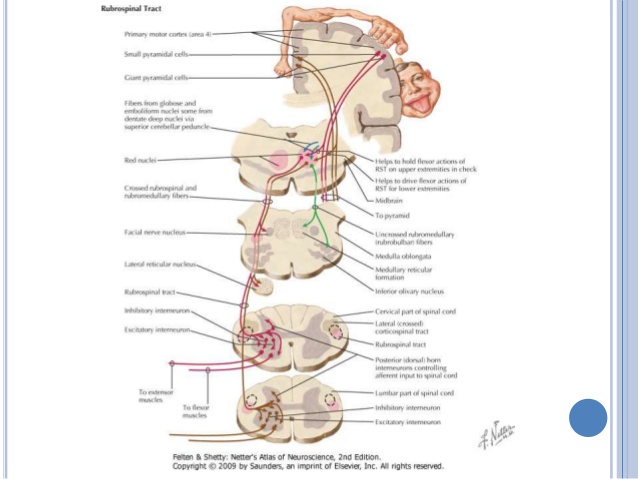
The Fleeting Nature of Meditative Consciousness
This qualitatively transforms my subjective experience of consciousness. Since the mind is disengaged from higher-level cognition, it proves challenging to consciously interrogate the qualities of this state of mind. When you first activate a state of mind like this, you may have a ‘Whoa WTF was that?’ moment. When this first happened to me, I was suddenly projected an image behind two people holding hands in front of a sunrise or sunset. It seemed to come from outside or it was at least an image I did not consciously wander into. I didn’t expect it and so immediately tried to reflect on it. Instantly, I lost balance and awoke from my group meditation, almost gasping for air.
Downregulation of Ordinary Neural Circuit Flow Results in Decentralized Crosstalk
In many ways, these lower-level neural circuits exhibit transistor-like behavior: their structure dampens or amplifies signal downstream. Downregulation of ordinarily engaged circuits results in profoundly different states of mind. When the usual signal is quieted, your mind disengages from its usual fluid flows, whose constant erosion has resulted in strongly upregulated circuits in your brain, like the Default Mode Network. Neural activity for this network in particular the should become recessed.
In fact, meditation’s effects on DMN are so pronounced, it’s being studied as a biomarker for monitoring the therapeutic effects of meditation. Even in academia, it has been demonstrated that meditation leads to reduced default mode network activity beyond an active task.
Parietal Gyrus - Dr. Greg Dunn
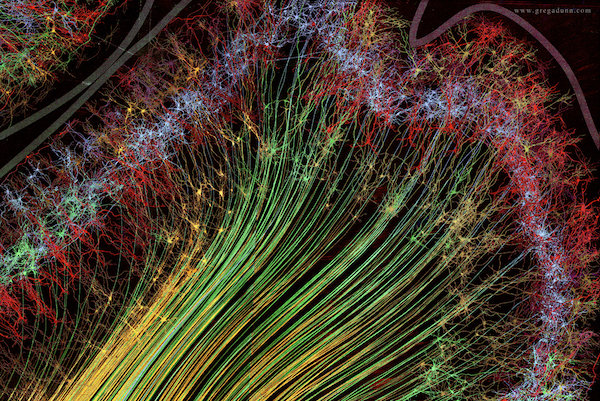
Meditation Produces More Natural Neural Decentralization Than Psychedelics
Since the mind flows through the brain like a river, stemming its flow in one area results in increased activity elsewhere, though it is not zero-sum. This sudden void of consciously engaged neural pathways encourages circuits to fire and connect in decentralized ways. Psychedelics also encourage networks of the brain that are usually unconnected to become connected by encouraging neural crosstalk. However, psychedelics induce this in a harsh, artifical way with chemicals that globally affect all regions of the brain, whereas spiritual practice gently encourages decentralized neural activity.
Task-Specific Overclocking of Neural Circuitry Presents Regional Variance In Resource Consumption
When commonly active states of mind are recessed, this also tones down nutrient and energy-intensive processes. Depending on how your active cognition engages the modular functionality of the mind for specific tasks, these circuits regularly run hot. In the brain, both distribution and consumption of energy and nutrients exhibit localized variation. This local variance in resource consumption yields the phenomenon of short-term burnout for highly repetitive, cognitively taxing activities. This can usually be addressed with cardio exercise to trigger fluid flux or simply by taking a short break. To abuse an idiom, variety is the spice of life.
Self-Reflected - Dr. Greg Dunn
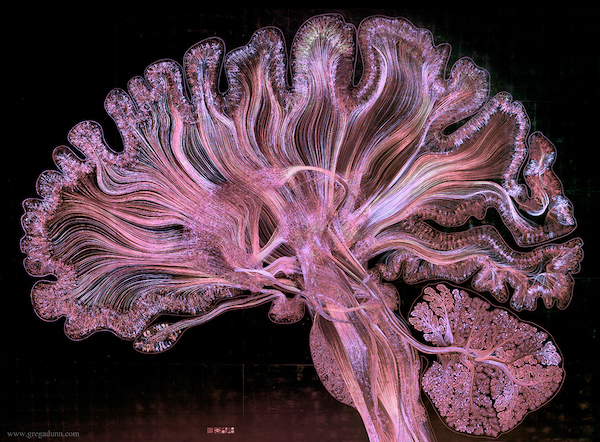
Cognition With Diminished Conceptual Designation
While meditating, your mind is calm and relaxed and encouraged to drift. When your mind engages in conceptual designation, you map structured meaning onto qualia. As you engage in higher forms of cognition, your mind becomes increasingly bound to preexisting concepts it weaves and layers on top of its experience of itself. By doing this, the mind categorizes aspects of its sensory and cognitive experiences.
In modern life, we simply do not experience life without a strong reliance on cognitive patterns heavily dependent on conceptual designation. This phenomena of modern life presents itself in the extreme. Many of us – perhaps most – may not experience states of mind with conceptual designation diminished beyond the threshold that makes that state of consciousness appreciably distinct. That is, some of us may never experience these altered flows of consciousness.
For Wetware Computing Architectures, Form IS Function And There Are Mathematic Maximal Networking Bounds For Local Computation
Moreover, transhumanism and brain-computer interfaces (BCI) may permanently divorce humanity from some preexisting spiritual internet connection, which is why I will never modify my brain in that way. I’ve maintained that view for years now, since transhumanism represents the technological embodiment of the left-hand path.
The Spinal Dermatome: Tactile Regions Mapped To Their Nerves. Form IS Function.
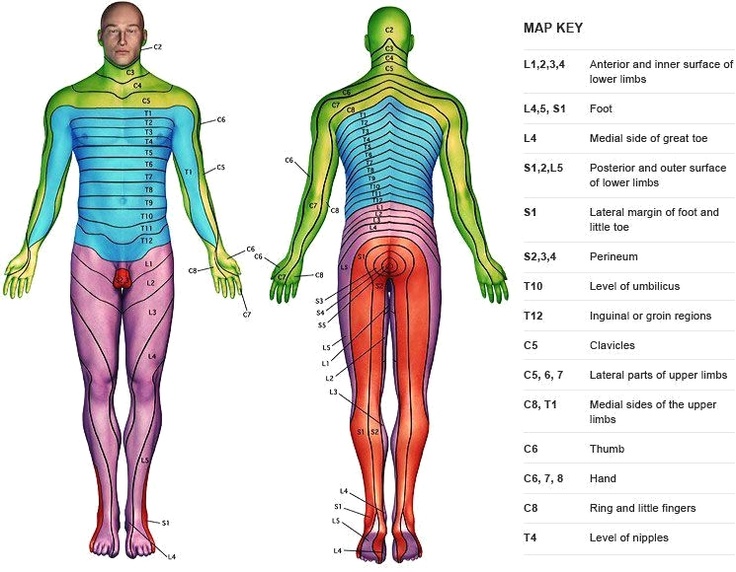
Any crude BCI will certainly distort behavior of circuits and regions, eventually physically deforming them. Without massive structural changes, it’s not clear that the brain can actually extend the mind’s capacity to process significantly more information that it already does. Most of that computaton would need to be external, but exposed to the brain as a sense. Unfortunately, the only sense that is exposes semiotic and semantic data to the mind is memory. It is not the hardware interface of a BCI that is technically prohibitive, it is the software interface. Perhaps quantum or nano would change nature and quality of these limitations.
No, Your Hedonistic Paradise Only Diverts The Productive Energy of the Populus
If your transhumanist philosophy and/or political strategies are banking on virtualizing a hedonistic plane of pleasure as a newfound fentanyl of the masses, you really need to pay attention to what is specifically enabled by the technology, technically, phenomenologically and teleologically. Society must conquer technonihilism’s tendancy to obliterate the individual. What truly is the meaning to life, of life? As timeless as they are, we must answer those questions. Whether we take a hard right or hard left, we are certainly racing towards a world where the penultimately powerful few control the rest of us via ownership of technology. As much as the pragmatic and materialistic want to write off philosophy as a liberal art with no economic utility, the battles we face are philosophical.
Nerve Bundling in the Spinal Column: Arranged In ~2D~ Space (Flexor/Extensor X Homunculus)
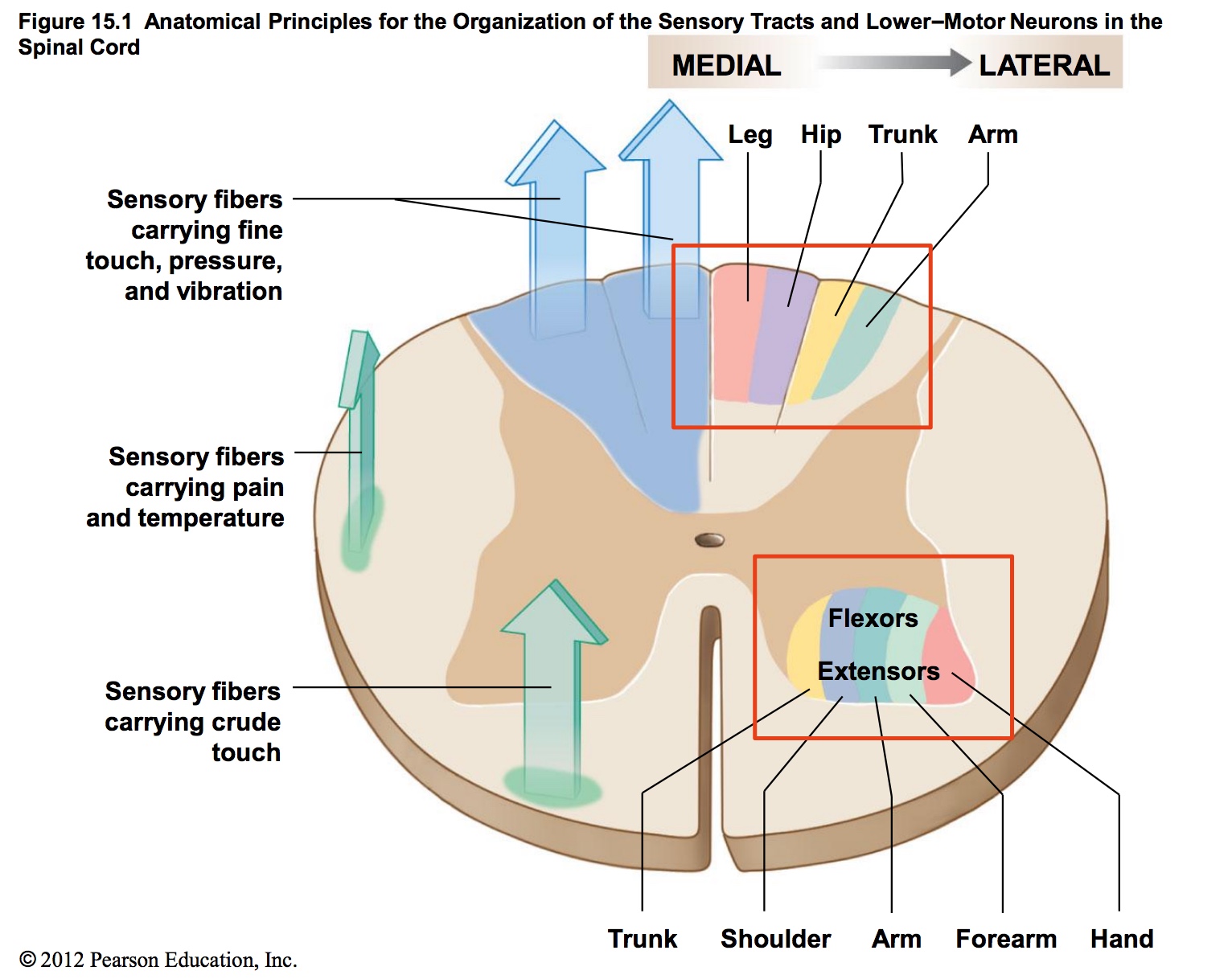
Did you notice how the arrangement of nerves in the spinal column can be simplified into a two dimensional arrangement? Look at the areas in the red box. Such an understanding of nerve arrangements is required for surgery or cybernetics. If you combine this understanding with knowledge of neural networks and machine learning, especially as applied biologically, then you will understand what I understand: transhumanism’s intent to modify function & form of the human brain should provoke concern.
With BCI technology, if we permanently divorce ourselves from our wetware’s true spiritual connection, what then? Are we permanently damned to the left-hand path? This all depends on the specifics of the technology, of course. Again, variety is the spice of life; we need variety of body, mind and spirit; anything that is to be adopted by 100% of a population needs to be viewed with utmost skepticism.
Monadic Metaphysics, Cognition and Meditation
What impacts do various conceptions of metaphysics have on the human mind, on cognition and on meditative states of mind? Some meditative practices encourage the development and experience of states of mind where conceptual designation is recessed. Conceptual designation occurs when the mind imbues our sensory experience with layers of metaphysical forms. This article dives into conceptual designation more completely as it relates to meditation.
In The Image Below, What Does Your Mind Notice First, Conceptually?

Meditation with Lucidity and Wide Spectra of Sensory Input
Meditative practices encourage the development of these altered modes of consciousness. They are relaxing. It feels good. Furthermore, these states of mind may provide an experiential basis for metaphysical understanding. I have always wondered whether it’s possible to develop meditative skills to maintain a state of mind like this while ‘lucid’ or at least with the eyes open. A neurological understanding of how these states arise in your mind implies that changing the categories of sensory stimulation may also change subjective and objective aspects of these states. With more skill, can one maintain meditative states of mind with more sensory input?
Above, Enumeration of Primative Forms From Graph Theory In Analytic Combinatorics, Seen in Goodwill Hunting

What did your mind notice first, in the image above? Did it read the unfamiliar vocabulary of datascience? Or did it notice the simply the presence of words in English or Kanji? Or, most likely, it choose to “see” the whale or the fish first, but which one? This is conceptual designation. Can you turn it off? Can you look at this image with zero associations to the images, the text or anything else, especially with high-contrast colors and the immediate unconscious stimiluation of linguistic content? It’s almost impossible, isn’t it?
Sensory Stimuli Triggers Conceptual Designation, Which Woven Together Constructs Cognitive State
This Cognitive State Ranges from Short-term to Long-term. Short-Term Cognitive State is Easily Disrupted
Sensory stimuli easily trigger conceptual designation, which is partly why most of us learn to meditate in a relaxed state with their eyes closed. The diminished degree of input means the mind is less likely to become attached to sensory experience. Visual stimuli in particular provoke this conceptual designation: have you ever tried to look at written words without reading them or allowing those well-worn subconscious pathways to activate at all? Even if the language is unfamiliar, the mind begins layering information onto your experience the moment it enters your visual field. When meditating, the goal is to turn all of that off, almost impossible with visual stimulation, since your mind is preprocessing and caching data, layering in conceptually designated information.
What would it mean to operate in a quasi-lucid state of consciousness where most of these processes of semantic or semiotic designation are diminished? Diminished conceptual designation means that you might hear a sound, but your focus does not drift towards attending to it. Your mind does not try to label thoughts or sensory input, even when you experience distracting sensory stimuli. You are encouraged to deal with thoughts that arise as they arise, but to avoid dwelling on them. Apparently zazen meditation should be performed with the eyes half-open. I’ve tried it a few times. It’s difficult. If you train yourself to do this with zazen, then perhaps it alters how you experience fleeting “third eye” visual phenomena.
Because This Image Is So Fantastic…

Meditative States of Mind Do Not Uniquely Emerge From Meditation
There are many types of meditative states of mind. One must devote their lives to study from spiritual masters in order to advance. It is possible to spontaneously develop these understandings, whatever you might name them or call them, but it is not possible to learn these things from a book or a blog. You must learn from experience and devotion through apprenticeship is perhaps the best way.
If these states could be maintained, what would other, more lucid or more open meditative states of mind be like? What would my experience be like? language must require conceptual designation. I assume that almost all structured thought would as well. Is this similar to the state of mind I feel when I play piano, either memorized or improvised? Is it similar to what I feel when I’m dancing and I’m hyperfocused, yet not focused at all? When I’m engaging in these activities, I feel varying degrees of constraint/structure on my cognitive processes. When I’m not trying to structure what I’m doing and I don’t need to think about it, that’s when I perform the best. My mind begins to wander or will simply fade into the background. I become the music, but part of my mind is freed to reflect back on itself, yet there’s the same ephemerality: if I try to hard to control or focus that freed element of my mind, it breaks the meditative state of mind.
Invoking True Being
Is this what it feels like to truly exist? Is this what truly being feels like? Are there those of use who can activate these states of mind more naturally? Is this why we can feel the soul in live music? Is it because the performers become one with themselves and one with the audience? Is there some connection established that no Grateful Dead recording could ever replicate?
Gotcha? Real or Re-Lu, She Has The Prima Materia

What is the most basic substance of metaphysics? The metaphysical
atom? It is the monad, but the true essence of the monad is infinitely
distance. It is only through the monad proxy that, through this
conceptualization can all the Platonic forms be conceptualized. As the
forms extend infinitely outward with the monad proxy, they
asymptotically converge to one: the monad itself. Thus, meditation
would give us an a posteriori understanding of metaphysical oneness.
A Posteriori, Experiential Understanding of Metaphysics
Total non-conceptual awareness means you mind is not laying down any structure onto your experience: semantic, linguistic or semiotic. I believe this lack of structure in the mind means you experientially begin to approach this oneness, yourself. You contract the tendancy to “know” anything, to label any part of your experience, sensory or semiotic. Does this state of mind, when practiced to elusive perfection, eventually reach an experiential understanding of oneness? Does this experience approach that of the one is the all, the all is the one? If so, this is functionally linked to a monadic model of metaphysics.
Infinitely Inwards And Infintely Outwards Are One And The All
Your being contracts inwards, but also infinitely outwards. Therefore, idealized states of mind produce an experiential understanding of this oneness and allness. You experience the monad: which I believe to be the prima materia, or the starting material for the philosopher’s stone. It is through an vivid, seasoned understanding of this state of mind that we are able to model, conceptualize and transvalue all things. From here, we begin our journey to transform ourselves and our surroundings from lead into gold.
Looking Back On Yourself Looking Back At Yourself
